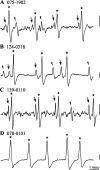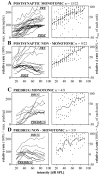Interaction of excitation and inhibition in anteroventral cochlear nucleus neurons that receive large endbulb synaptic endings
- PMID: 12486196
- PMCID: PMC6758445
- DOI: 10.1523/JNEUROSCI.22-24-11004.2002
Interaction of excitation and inhibition in anteroventral cochlear nucleus neurons that receive large endbulb synaptic endings
Abstract
Spherical bushy cells (SBCs) of the anteroventral cochlear nucleus (AVCN) receive their main excitatory input from auditory nerve fibers (ANFs) through large synapses, endbulbs of Held. These cells are also the target of inhibitory inputs whose function is not well understood. The present study examines the role of inhibition in the encoding of low-frequency sounds in the gerbil's AVCN. The presynaptic action potentials of endbulb terminals and postsynaptic action potentials of SBCs were monitored simultaneously in extracellular single-unit recordings in vivo. An input-output analysis of presynaptic and postsynaptic activity was performed for both spontaneous and acoustically driven activity. Two-tone stimulation and neuropharmacological experiments allowed the effects of neuronal inhibition and cochlear suppression on SBC activity to be distinguished. Ninety-one percent of SBCs showed significant neuronal inhibition. Inhibitory sidebands enclosed the high- or low-frequency, or both, sides of the excitatory areas of these units; this was reflected as a presynaptic to postsynaptic increase in frequency selectivity of up to one octave. Inhibition also affected the level-dependent responses at the characteristic frequency. Although in all units the presynaptic recordings showed monotonic rate-level functions, this was the case in only half of the postsynaptic recordings. In the other half of SBCs, postsynaptic inhibitory areas overlapped the excitatory areas, resulting in nonmonotonic rate-level functions. The results demonstrate that the sound-evoked spike activity of SBCs reflects the integration of acoustically driven excitatory and inhibitory input. The inhibition specifically affects the processing of the spectral, temporal, and intensity cues of acoustic signals.
Figures












Similar articles
-
Inhibitory properties underlying non-monotonic input-output relationship in low-frequency spherical bushy neurons of the gerbil.Front Neural Circuits. 2015 Mar 31;9:14. doi: 10.3389/fncir.2015.00014. eCollection 2015. Front Neural Circuits. 2015. PMID: 25873864 Free PMC article.
-
Inhibition shapes acoustic responsiveness in spherical bushy cells.J Neurosci. 2015 Jun 3;35(22):8579-92. doi: 10.1523/JNEUROSCI.0133-15.2015. J Neurosci. 2015. PMID: 26041924 Free PMC article.
-
Transmission of phase-coupling accuracy from the auditory nerve to spherical bushy cells in the Mongolian gerbil.Hear Res. 2010 Sep 1;268(1-2):234-49. doi: 10.1016/j.heares.2010.06.005. Epub 2010 Jun 16. Hear Res. 2010. PMID: 20561574
-
Modulatory influences on time-coding neurons in the ventral cochlear nucleus.Hear Res. 2019 Dec;384:107824. doi: 10.1016/j.heares.2019.107824. Epub 2019 Oct 17. Hear Res. 2019. PMID: 31670183 Review.
-
Short-term plasticity and auditory processing in the ventral cochlear nucleus of normal and hearing-impaired animals.Hear Res. 2011 Sep;279(1-2):131-9. doi: 10.1016/j.heares.2011.04.018. Epub 2011 May 10. Hear Res. 2011. PMID: 21586317 Free PMC article. Review.
Cited by
-
Postsynaptic targets of type II auditory nerve fibers in the cochlear nucleus.J Assoc Res Otolaryngol. 2004 Jun;5(2):111-25. doi: 10.1007/s10162-003-4012-3. J Assoc Res Otolaryngol. 2004. PMID: 15357415 Free PMC article.
-
A map of functional synaptic connectivity in the mouse anteroventral cochlear nucleus.J Neurosci. 2014 Feb 5;34(6):2214-30. doi: 10.1523/JNEUROSCI.4669-13.2014. J Neurosci. 2014. PMID: 24501361 Free PMC article.
-
BDNF in Lower Brain Parts Modifies Auditory Fiber Activity to Gain Fidelity but Increases the Risk for Generation of Central Noise After Injury.Mol Neurobiol. 2016 Oct;53(8):5607-27. doi: 10.1007/s12035-015-9474-x. Epub 2015 Oct 17. Mol Neurobiol. 2016. PMID: 26476841 Free PMC article.
-
Enhancement of phase-locking in rodents. I. An axonal recording study in gerbil.J Neurophysiol. 2017 Oct 1;118(4):2009-2023. doi: 10.1152/jn.00194.2016. Epub 2017 Jul 12. J Neurophysiol. 2017. PMID: 28701535 Free PMC article.
-
Auditory nerve inputs to cochlear nucleus neurons studied with cross-correlation.Neuroscience. 2008 Jun 12;154(1):127-38. doi: 10.1016/j.neuroscience.2008.01.036. Epub 2008 Feb 5. Neuroscience. 2008. PMID: 18343587 Free PMC article.
References
-
- Abeles M, Goldstein MH. Multispike train analysis. Proc IEEE. 1977;65:762–773.
-
- Adams JC. Heavy metal intensification of DAB-based HRP reaction product. J Histochem Cytochem. 1981;29:775. - PubMed
-
- Bazwinsky I, Härtig W, Rübsamen R. Distribution of different calcium binding proteins in the cochlear nucleus of gerbil and opossum (Abstract 260). Presented at Midwinter Meeting of the Association for Research in Otolaryngology. St. Petersburg Beach, FL, February; 1999.
-
- Blackburn CC, Sachs MB. Classification of unit types in the anteroventral cochlear nucleus: PST histograms and regularity analysis. J Neurophysiol. 1989;62:1303–1329. - PubMed
-
- Brawer JR, Morest DK. Relations between auditory nerve endings and cell types in the cat's anteroventral cochlear nucleus seen with the Golgi method and Nomarski optics. J Comp Neurol. 1975;160:491–506. - PubMed
Publication types
MeSH terms
LinkOut - more resources
Full Text Sources
